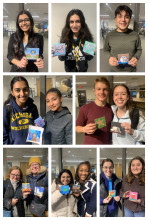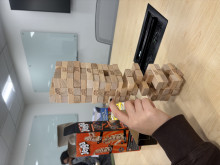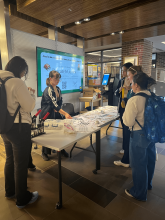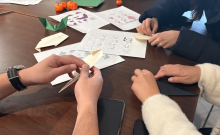Alyssa Simone Wakefield
Posts tagged with student engagement program
Showing 1 - 10 of 22 items

On Friday, November 21st, the library Student Ambassadors hosted a Sip and Paint in the third floor Shapiro Gallery!

On Thursday, November 6th, the library student ambassadors hosted a spectacular Board Game Night on the 4th floor of the Shapiro Library!

The Library Student Ambassadors hosted Pronoun Pin Day earlier this month in the Shapiro Lobby on Friday, October 10th, otherwise known as National Coming Out Day!

This Halloween, we went deep into the Hatcher Library stacks and the Hatcher Library lore with our Hatcher Haunts tours.

The Library Student Ambassadors hosted an “Instagram Takeover” of the @umichstudents Instagram account last week, sharing past and upcoming library events, what students can use the library for, as well as library resources students have access to.

The library Student Ambassadors hosted the annual Postcard Writing event right outside the Shapiro Undergraduate Library on Friday, September 26th from 2-5 PM.

The Library Ambassadors held Info Tabling sessions for all students to learn more about the services the library has to offer.

Annie Zhou, a second-year master’s student in Educational Studies, explores culturally responsive teaching and what constitutes "good teaching".

According to The Western Architect, four hundred and fifty million bricks were used in construction in Detroit in 1916. Among the brick buildings featured in this reporting is the Victor Theatre, located near the Ford factory that was, at the time, the largest manufacturing site in the world in Highland Park, an autonomous city in the center of Detroit. Today, this building is the main location of the Ruth Ellis Center, a nonprofit organization providing social and medical services to LGBTQ youth in metropolitan Detroit. While the exterior of the building is now unrecognizable – the façade covered over in the intervening years – certain interior spaces in the theater have been preserved: the detailed proscenium arch framing the stage-turned-conference-room and the upstairs dance hall where, prior to the novel coronavirus pandemic and enforced social distancing, youth gathered to share meals and vogue during the Center’s drop-in hours.

From the beginning of my time as a transfer student to the University of Michigan in the Fall of 2019, I have been interested in both engaging with the transfer community and improving the overall transfer student experience. When preparing for this big transition over the summer of 2019, I was most concerned with adjusting socially and academically to a new school. However, when I actually got here, I found there were many other, more hidden aspects of campus life that I had to figure out on my own. For example: Which buildings require swipe access? Where can I scan a document? What is the “UgLi,” and is it a good place for group work?
I think we don’t often consider how all these little questions and struggles add up to create the transfer student experience. Transfer student success is often measured by quantitative academic markers; students themselves are concerned with adjusting academically and socially. I’m sure I’m not alone in saying that concerns about how to use the library as a transfer were far from the first thing on my mind. So, when looking for social science research opportunities this fall, I was intrigued by a position that entailed analyzing the specific library needs of transfer and commuter students. I saw it as an opportunity to engage with the transfer student experience through the unique, and often undervalued, lens of the library.
Ultimately, this interest led to me joining the Library Research & Evaluation team as a Research Assistant, as part of the Library Engagement Fellows Program. Through this position, I was able to utilize and strengthen my social science research skills through a project I am personally invested in and passionate about. Additionally, this position exposed me to library functioning and the specific resources offered by the University of Michigan Library.
I think we don’t often consider how all these little questions and struggles add up to create the transfer student experience. Transfer student success is often measured by quantitative academic markers; students themselves are concerned with adjusting academically and socially. I’m sure I’m not alone in saying that concerns about how to use the library as a transfer were far from the first thing on my mind. So, when looking for social science research opportunities this fall, I was intrigued by a position that entailed analyzing the specific library needs of transfer and commuter students. I saw it as an opportunity to engage with the transfer student experience through the unique, and often undervalued, lens of the library.
Ultimately, this interest led to me joining the Library Research & Evaluation team as a Research Assistant, as part of the Library Engagement Fellows Program. Through this position, I was able to utilize and strengthen my social science research skills through a project I am personally invested in and passionate about. Additionally, this position exposed me to library functioning and the specific resources offered by the University of Michigan Library.